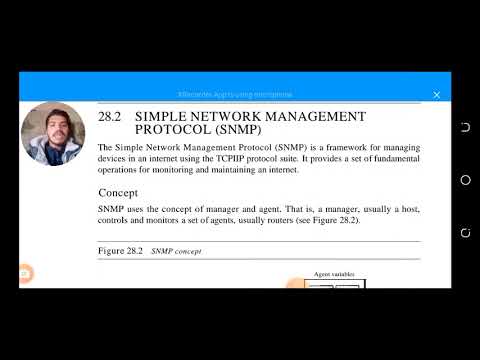chapter 2 is simple network management protocol
SIMPLE NETWORK MANAGEMENT
PROTOCOL (SNMP)
The Simple Network Management Protocol (SNMP) is a framework for managing
devices in an internet using the TCPIIP protocol suite. It provides a set of fundamental
operations for monitoring and maintaining an internet.
Concept
SNMP uses the concept of manager and agent. That is, a manager, usually a host,
controls and monitors a set of agents, usually routers (see Figure 28.2).
Figure 28.2 SNMP concept
Agent variables
Agent
Internet 1——.-‘1;’:’ :1
—,….,– Manager
SNMP is an application-level protocol in which a few manager stations control a
set of agents. The protocol is designed at the application level so that it can monitor
devices made by different manufacturers and installed on different physical networks.
In other words, SNMP frees management tasks from both the physical characteristics
of the managed devices and the underlying networking technology. It can be used in a
heterogeneous internet made of different LANs and WANs connected by routers made
by different manufacturers.
878 CHAPTER 28 NETWORK MANAGEMENT: SNMP
Managers and Agents
A management station, called a manager, is a host that runs the SNMP client program. A
managed station, called an agent, is a router (or a host) that runs the SNMP server program.
Management is achieved through simple interaction between a manager and an agent.
The agent keeps performance information in a database. The manager has access
to the values in the database. For example, a router can store in appropriate variables
the number of packets received and forwarded. The manager can fetch and compare the
values of these two variables to see if the router is congested or not.
The manager can also make the router perform certain actions. For example, a
router periodically checks the value of a reboot counter to see when it should reboot
itself. It reboots itself, for example, if the value of the counter is O. The manager can
use this feature to reboot the agent remotely at any time. It simply sends a packet to
force a 0 value in the counter.
Agents can also contribute to the management process. The server program running
on the agent can check the environment, and if it notices something unusual, it can send
a warning message, called a trap, to the manager.
In other words, management with SNMP is based on three basic ideas:
1. A manager checks an agent by requesting information that reflects the behavior of
the agent.
2. A manager forces an agent to perform a task by resetting values in the agent database.
3. An agent contributes to the management process by warning the manager of an
unusual situation.
Management Components
To do management tasks, SNMP uses two other protocols: Structure of Management
Information (SMI) and Management Information Base (MIB). In other words, man agement on the Internet is done through the cooperation of the three protocols SNMP,
SMI, and MIB, as shown in Figure 28.3.
Figure 28.3 Components ofnetwork management on the Internet
Management
I SNMP
8MI I MIB I
Let us elaborate on the interactions between these protocols.
RoleofSNMP
SNMP has some very specific roles in network management. It defines the format of
the packet to be sent from a manager to an agent and vice versa. It also interprets the
SECTION 28.2 SIMPLE NETWORK MANAGEMENT PROTOCOL (SNMP) 879
result and creates statistics (often with the help of other management software). The
packets exchanged contain the object (variable) names and their status (values). SNMP
is responsible for reading and changing these values.
SNMP defines the format of packets exchanged between a manager and an agent.
It reads and changes the status (values) of objects (variables) in 8NMP packets.
by the education corner
simple network management protocol



